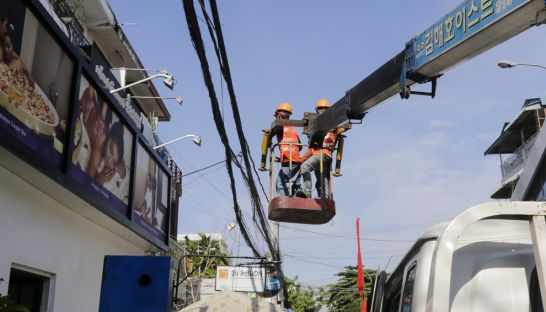Call for affordable electricity
Call for affordable electricity
Cambodia's electricity sector needs to focus on adopting the latest technology to reap the full benefits of its coal-fired and hydropower plants if the government is to achieve its 2020 goal of nationwide electrification, visiting executives from the US-based energy giant General Electric (GE) said yesterday.

Speaking at a workshop hosted by GE and the Ministry of Mines and Energy, Wouter Van Wersch, GE ASEAN president and CEO, said for Cambodia to further grow economically, it was critical to reduce the cost of electricity through smart and clean investments.
“With the government’s development strategy focused on the three main pillars of tourism, agriculture and garments, all of these need affordable electricity to grow,” he said. “Technology will reduce the cost of electricity as well as limit the environmental impact of power generation.”
Besides focusing on reducing energy costs, Van Wersch said having reliable energy transmission was important as the country intensifies manufacturing and seeks its 2020 goals.
US Ambassador William Heidt, who applauded the Kingdom’s efforts to increase domestic energy production, grid efficiency and expansion over the last 15 years, noted however that the high cost of electricity was one of the main challenges to long-term economic growth and industrial diversification as electricity transmission has yet to be optimised.
“A 2013 report by the World Bank showed that electricity distribution losses were about 27 percent of output, which is high by regional standards,” he said. “Making the grid more efficient would transform Cambodia’s ability to provide reliable and affordable energy to the people with potentially huge cost savings.”
Speaking on the sidelines of the event, Van Wersch described that 27 percent transmission loss as “terrible.”
“This is a big loss getting the electricity to where it needs to go,” he said.
Van Wersch said that while GE was currently bidding on outfitting existing coal and hydro plants in Cambodia, as well as unnamed future projects and transmission lines, he declined to elaborate on these projects or the company’s investment.
Cambodia currently has two coal-fired power plants located in Preah Sihanouk province, one partially owned by Cambodian People’s Party Senator Lao Meng Khin’s Cambodia International Investment Development Group (CIIDG), and another by Malaysian-owned Leader Universal Holdings.
“While coal is no longer a big producer in the US and Europe, it will continue to be a much-needed power asset in Asia because it is relatively cheap,” Van Wersch said. “And Cambodia will have more coal projects coming online.”
Victor Jona, director-general of the Ministry of Mines and Energy, said that in the long term, hydropower would dominate the Kingdom’s energy production. But coal had a role to play, and Sihanoukville was a prime location given its coastal shipping capacity.
“We already have two plants down there and we are reviewing a project submitted by Royal Group to build another plant,” he said. “While we haven’t yet approved the plan, I believe the government will soon include it as part of the next step for energy production.”
In its annual report issued last month, the Electricity Authority of Cambodia (EAC) reported that domestic electricity production had increased by 47 percent in 2015. While this had not resulted in a measurable decline in prices, Jona insisted that tariffs in Sihanoukville would soon fall from their current levels of around $0.25 per kilowatt-hour.
“With the coal-fired plants fully operational and connected to the grid and the country’s substations, next year the electricity tariffs will be no more than $0.12 per kilowatt-hour,” he said. “Where the EdC [Electricite du Cambodge] needs to invest in is power transmission, and that is one part where GE can help.”
While EdC officials at the event raised concerns about the Kingdom’s perceived over-reliance on hydropower, which can produce limited loads during the dry season when peak demand occurs, Nigel Hales, senior business development manager for GE, said that coal was the only solution to alleviate that fear.
“However, while fossil fuel use is growing in Cambodia and demand is increasing, coal needs to become as clean as possible,” he said. “To do this, emissions need to be reduced with constant monitoring of efficiency and maintenance.”
Brian Moran, a senior engineer for GE based in Thailand, said that due to the fledgling nature of Cambodia’s national grid, it was necessary to build coal plants with the highest efficiency to reduce emissions and remain flexible as the quality of coal declines globally.
“As more coal plants become operational, operators need to analyse how they are being used across the grid, especially if plant performance is lower than expected and coal prices or quality changes,” he said.













